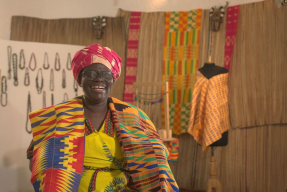
By Julie Shea, KF12
Since arriving at Manuela Ramos’s Puno office on August 12th, I have attended ten Community Bank monthly meetings and interviewed approximately 70 clients. In theory, the routine is the same: I meet up with the Community Bank’s Loan Officer (sometimes as early as 6am because we have far to travel), and we head off to the meeting together, often traveling via ”combi” (small vans) to ”moto-taxi” (motorcycle taxis) to car to ”moto-taxi”…depending on how remote the location of the meeting is, always the trip involves multiple modes of transportation, often it involves waiting for more passengers (drivers won’t leave until every seat is occupied, preferably all standing room should be occupied too), and sometimes it involves walking the last stretch.
After ten times repeating this procedure I have just one thing to conclude. No two meetings are the same and no two community banks are the same. Each and every one of those ten times, something has happened that I didn’t see coming. Moreover, there is such variance in the characteristics of each bank, the way the members interact with one another, where the meeting is held, and how the loan officer chooses to conduct the meeting. While I have witnessed times when the atmosphere is positive and all the bank members are anxious to express their gratitude towards Manuela Ramos, I have also been to meetings where the members are frustrated with high interest rates and unreasonable repayment schedules.
Click to view slideshow.Call me ambitious, but I came to Peru armed with the question ”Does microfinance work?” I would even have settled for an answer to whether the model used by Manuela Ramos in the context of Peru works. I don’t know how I’m ever going to answer these questions if I can’t make sweeping generalizations! If the banks within one microfinance institution (MFI) vary so greatly, it must be assumed that these banks vary from other institutions (with different models), from other regions of Peru, from other South American countries, from other developing countries…
The point I’m trying to illustrate is nothing new in the microfinance debate; it’s tough to measure/quantify/qualify the work of MFI’s and whether or not they are actually “doing good.” (This leads to a whole different debate about what “doing good” is and what we expect from microfinance – poverty alleviation, the betterment of clients’ lives, the economic development of the countries involved?) Moreover, the lessons learned in one region can rarely be applied directly to another country. In my first blog post I promised not to let my education in international development get in the way of my learning – but I’m quickly beginning to realize that my teachers are right in emphasizing the importance of context.
Julie Shea is a Kiva Fellow currently working with the different branches of Manuela Ramos/CrediMujer in Peru. After a month of freezing in Puno, she is headed to the rainforest to spend a month at their Pucallpa branch office.
PREVIOUS ARTICLE
Kiva Internship Opportunity - Social Performance →NEXT ARTICLE
Happy Indepen-dance →













